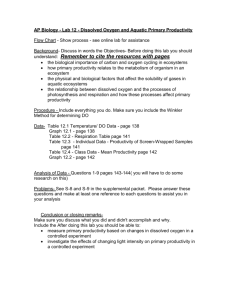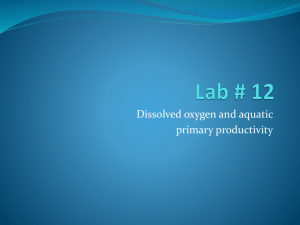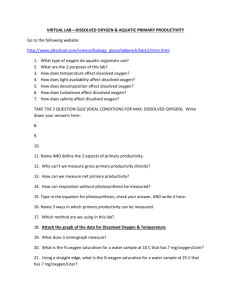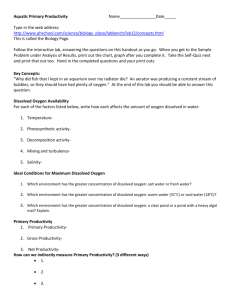Primary Productivity Lab Experiment: Aquatic Ecosystems
advertisement
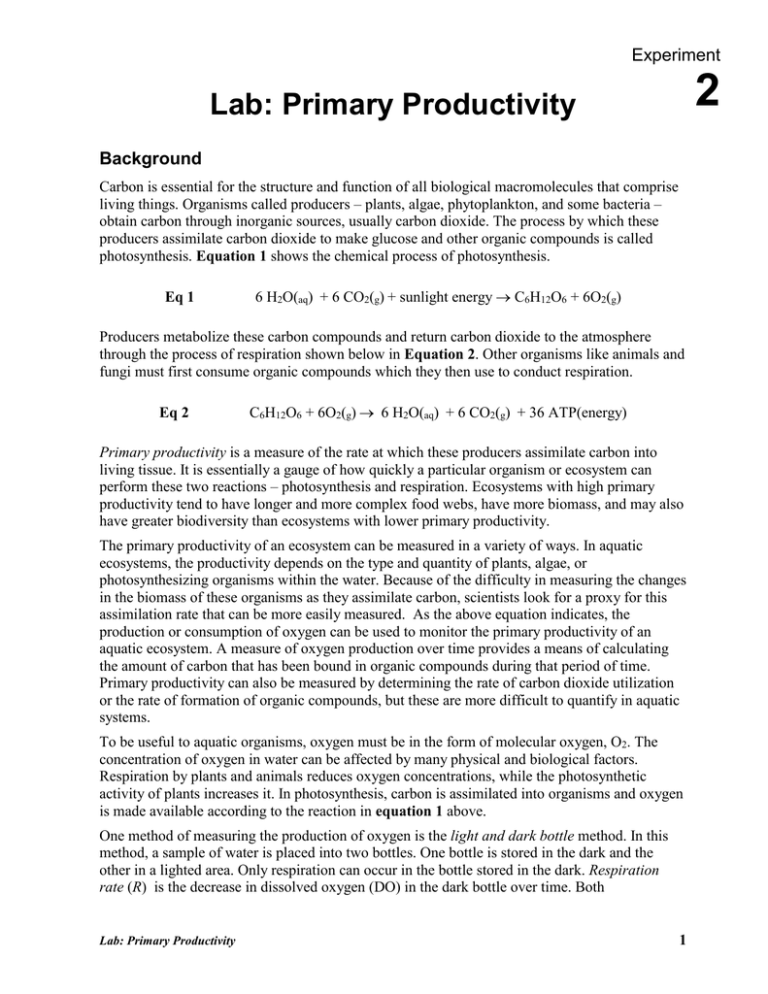
Experiment 2 Lab: Primary Productivity Background Carbon is essential for the structure and function of all biological macromolecules that comprise living things. Organisms called producers – plants, algae, phytoplankton, and some bacteria – obtain carbon through inorganic sources, usually carbon dioxide. The process by which these producers assimilate carbon dioxide to make glucose and other organic compounds is called photosynthesis. Equation 1 shows the chemical process of photosynthesis. Eq 1 6 H2O(aq) + 6 CO2(g) + sunlight energy C6H12O6 + 6O2(g) Producers metabolize these carbon compounds and return carbon dioxide to the atmosphere through the process of respiration shown below in Equation 2. Other organisms like animals and fungi must first consume organic compounds which they then use to conduct respiration. Eq 2 C6H12O6 + 6O2(g) 6 H2O(aq) + 6 CO2(g) + 36 ATP(energy) Primary productivity is a measure of the rate at which these producers assimilate carbon into living tissue. It is essentially a gauge of how quickly a particular organism or ecosystem can perform these two reactions – photosynthesis and respiration. Ecosystems with high primary productivity tend to have longer and more complex food webs, have more biomass, and may also have greater biodiversity than ecosystems with lower primary productivity. The primary productivity of an ecosystem can be measured in a variety of ways. In aquatic ecosystems, the productivity depends on the type and quantity of plants, algae, or photosynthesizing organisms within the water. Because of the difficulty in measuring the changes in the biomass of these organisms as they assimilate carbon, scientists look for a proxy for this assimilation rate that can be more easily measured. As the above equation indicates, the production or consumption of oxygen can be used to monitor the primary productivity of an aquatic ecosystem. A measure of oxygen production over time provides a means of calculating the amount of carbon that has been bound in organic compounds during that period of time. Primary productivity can also be measured by determining the rate of carbon dioxide utilization or the rate of formation of organic compounds, but these are more difficult to quantify in aquatic systems. To be useful to aquatic organisms, oxygen must be in the form of molecular oxygen, O2. The concentration of oxygen in water can be affected by many physical and biological factors. Respiration by plants and animals reduces oxygen concentrations, while the photosynthetic activity of plants increases it. In photosynthesis, carbon is assimilated into organisms and oxygen is made available according to the reaction in equation 1 above. One method of measuring the production of oxygen is the light and dark bottle method. In this method, a sample of water is placed into two bottles. One bottle is stored in the dark and the other in a lighted area. Only respiration can occur in the bottle stored in the dark. Respiration rate (R) is the decrease in dissolved oxygen (DO) in the dark bottle over time. Both Lab: Primary Productivity 1 Experiment 2 photosynthesis and respiration can occur in the bottle exposed to light, however. The difference between the amount of oxygen produced through photosynthesis and that consumed through aerobic respiration is the net primary productivity (NPP). The difference in dissolved oxygen over time between the bottles stored in the light and in the dark is a measure of the total amount of oxygen produced by photosynthesis. The total amount of oxygen produced is called the gross primary productivity (GPP). The relationship between gross productivity, net productivity, and respiration can be summarized in equation 3. Eq 3 GPP = NPP + R The measurement of the DO concentration of a body of water is often used to determine whether the biological activities requiring oxygen are occurring and is an important indicator of pollution. Excess nutrients in aquatic systems can provide producers with the essential materials to increase their productivity leading to eutrophication. A consequence to eutrophication is that when these nutrients are completely utilized and becoming limited once more, many producers do not survive. The decomposition of plants, algae, and other producers by bacteria in aquatic systems can consume large amounts of oxygen, leaving the environment hypoxic or anoxic and uninhabitable by many other organisms. In the Preliminary Activity, you will gain experience using a Dissolved Oxygen Probe as you measure the DO level of a water sample provided by your teacher. You will also learn how to calculate respiration rate, gross productivity, and net productivity. You will then hypothesize the effect that adding nutrients will have on a particular aquatic system and measure their effect on the productivity and oxygen levels in that system. 2 Lab: Primary Productivity Primary Productivity After completing the Preliminary Activity, you will first use reference sources to find out more about primary productivity before you choose and investigate a researchable question dealing with primary productivity. Some topics to consider in your reference search are: Problem A local marina owner has become concerned about his waterfront. Over the summer, a new type of algae has begun to grow along the pilings of his pier. It also floats in the water. It is unsightly, discolors the bottom of his clients’ boats, and seems to make the water smell badly especially on very hot days. The marina owner has also learned that a wastewater treatment facility up river has applied for a permit to discharge partially treated sewage into a nearby wetland for the purpose of natural filtration. He is concerned that excess nutrients from this practice might make the situation at his marina worse. He has hired you to test the productivity of the aquatic ecosystem surrounding his marina and to predict the effects that excess nutrient inputs might have on it. Hypothesis Review the species of algae that have been found in the waterfront area near the local marina, conduct any research that you feel necessary, and then make a hypothesis about the two questions posed in the problem above. Materials Vernier Lab Pro or LabQuest Vernier Dissolved Oxygen sensor LaMotte Dissolved Oxygen test kit Culture tube with secure lid or BOD bottle aluminum foil lamp computer nitrate standard solution phosphate standard solution micropipette graduated cylinder Suggested Procedure 1. Obtain three BOD (biological oxygen demand) bottles or three culture tubes. Rinse bottles with pond water. Label the bottles/tubes as follows: Dark, Light, and Enriched. Place some identifying mark for your group on the outside of the bottles/tubes. 2. Fill Dark and Light bottles/tubes with pond water so that there is no air space. They MUST be completely filled. 3. Wrap the Dark bottle/tube completely with aluminum foil so no light can enter. Respiration will occur in this bottle. Lab: Primary Productivity 3 Experiment 2 4. Dose the Enriched bottle/tube so that the concentration of nitrate in the solution is between 0.5 and 1.5 mg/L. This will require you to know the volume of the bottle and the concentration of the standard solution. Use the following equation to determine the amount you need. desired concentration x V of container = Std concentration x V of std used where… desired concentration is between 0.5 and 1.5 mg/L, V of container is the volume of your bottle or tube, std concentration can be found on the stock bottle, and Vof std used is the amount of std you should use (this is your unknown in the equation.) 5. Dose the Enriched bottle/tube so that the concentration of phosphate in the solution is between 25 and 50 µg/L. Use the equation in #4 to determine the amount that you need. 6. Fill the Enriched bottle/tube with pond water so that there is no air space. It MUST be completely filled. Gently agitate the bottle/tube to mix the solution and the culture together. 7. Place all three bottles/tubes under the lamp by the window. 8. Follow steps 9-11 if using the dissolved oxygen probe. Otherwise follow the directions in the LaMotte test kit to determine the dissolved oxygen level of the original pond water sample. 9. Prepare the dissolved oxygen probe for use following instructions from your teacher. Place the probe in a beaker filled with about 100 ml of distilled water. 10. Connect the dissolved oxygen probe to the LabPro and open Logger Pro 3.8.5.1 from the Vernier Software folder. Open file 19 Dissolved Oxygen from the Biology with Computers menu. Allow the dissolved oxygen sensor to stay in the water for 5 minutes as the probe warms up. 11. To collect dissolved oxygen (DO) data: a. Place the tip of the probe into the water sample being tested. Submerge the probe tip to a depth of 4–6 cm. b. Start data collection. Gently stir the probe in the water sample. Note: It is important to keep stirring until you have finished collecting data. c. Continue stirring and data collection until the readings have been relatively stable (stable to the nearest 0.2 mg/L) for about 30 seconds, then stop data collection. d. Select the stable region of your graph, then display Statistics for that region. Note and record the mean value for that region as the DO of the water sample. 12. Wait 24 hours. Then measure the dissolved oxygen level of the Light, Dark, and Enriched bottles/tubes using the same method that you used to obtain the original dissolved oxygen measurement. 4 Lab: Primary Productivity Primary Productivity Data/Results Your laboratory report should include a data table that shows your data on the dissolved oxygen concentrations of each bottle/tube (initial, light, dark, enriched) that you tested. Furthermore good scientists repeat their work, so replicate data sets from other groups are encouraged. Calculations Because this is a quantitative laboratory, you must perform some calculations using your data to determine the productivity of the water at the marina and the effect that excess nutrients will have on the water. The final values for these should be presented in an organized table like Table 2-1. All calculations should be typed or neatly handwritten in your final laboratory report. Calculating Respiration Rate Only respiration can occur in a dark bottle. Respiration rate is the decrease in DO over time. To determine this for your sample, subtract the dark DO from the initial DO, then divide it by the time (usually in days). This will give an answer in mg O2/L/day. Use the formula below to assist you. Respiration rate initial DO dark DO time Calculating Gross Primary Productivity Gross Primary Productivity (GPP) is the total amount of carbon that was fixed by organisms over a period of time. To determine this for your sample, subtract the dark bottle DO from either the light or enriched bottle DO values, then divide it by the time (usually in days). This will give an answer in mg O2/L/day. Use the formula below to assist you. Lab: Primary Productivity 5 Experiment 2 Gross productivity light or enriched DO dark DO time Calculating Net Primary Productivity Net Primary Productivity (NPP) is the total amount of carbon that was fixed by organisms into living tissue minus that used for respiration over a period of time To determine this for your sample, subtract the respiration rate in mg O2/L/day from GPP in mg O2/L/day. This will give an answer in mg O2/L/day. Use the formula below to assist you. NPP = GPP - R You can also use the formula below to calculate the net primary productivity since the difference between the light bottle DO and the initial DO is essentially the same algebraic expression as GPP minus respiration rate. Net productivi ty light DO initial DO time Discussion You should use your data to evaluate your hypotheses. In a few short paragraphs you should: Restate your hypotheses and any assumptions that you made about the problem. Explain how your data and calculations lead to agree/disagree with your hypothesis. Research and explain any factors that might influence changes in the primary productivity of this waterfront area including any potential sources of cultural eutrophication. Briefly describe how your test results might change if you collected water samples and conducted these tests in winter, spring, or early summer. What new questions or areas of uncertainty still exist? How might you reduce experimental error and improve your experiment in the future? Resources AP Environmental Science Ecology Special Focus. (2008) The College Board. 6 Lab: Primary Productivity
